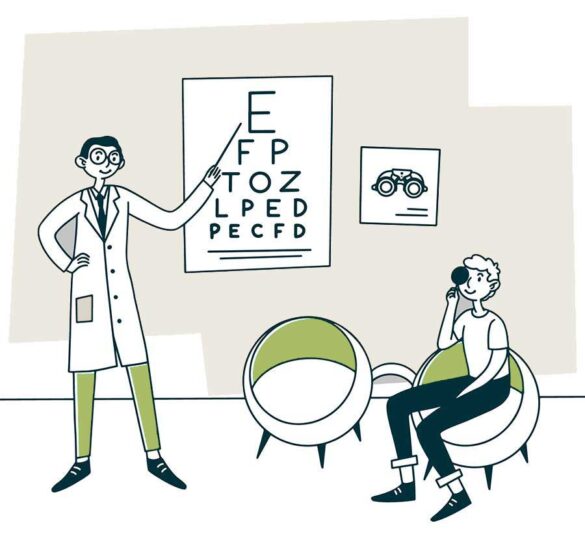The Consequences of Undiagnosed Glaucoma and How to Avoid Them
People often call glaucoma the silent thief of sight.

That’s because, if it goes undiagnosed, it can quietly steal vision without any warning signs — until the damage is permanent. The good news? You can take steps to protect your eyesight. In this post, we’ll talk about what happens when glaucoma goes unnoticed, how common it really is, and what you can do to safeguard your vision.
What Is Glaucoma?
Glaucoma isn’t just one disease — it’s actually a group of eye conditions that damage the optic nerve, the vital link between your eye and your brain. While it’s often tied to elevated eye pressure, that’s not always the case. Over time, this damage usually begins with the edges of your vision (your side vision) and slowly moves toward the center.
There are different types of glaucoma:
- Open-angle glaucoma: The most common type tends to creep in slowly and without pain.
- Angle-closure glaucoma: Less common than open-angle glaucoma, it can appear suddenly and requires immediate medical attention.
Why Glaucoma Matters
Worldwide, about 80 million people live with glaucoma, and in the US, more than 4 million people live with glaucoma. Because glaucoma often shows no symptoms early on, untreated cases can lead to severe vision loss or blindness. On a global scale, the World Health Organization lists glaucoma as the second leading cause of blindness. And while anyone can get glaucoma — even children — certain groups are at higher risk. These include African Americans, people with diabetes, adults over 60, those with a family history of glaucoma, and severely nearsighted individuals. Still, it’s important to remember that glaucoma can affect anyone, even without these risk factors.
Protecting Your Sight
Here’s the tricky part: glaucoma rarely causes noticeable symptoms in its early stages. That’s why regular, comprehensive eye exams with an eye doctor are the only reliable way to catch glaucoma early. Detecting glaucoma before vision loss begins makes all the difference — giving you the best chance to protect your sight for years to come.
How Common is Undiagnosed Glaucoma?
You might be surprised at just how often glaucoma goes undetected.
- Around the world, researchers estimated that in 2020, about 43 million people were living with undiagnosed primary open-angle glaucoma (POAG). And that number isn’t slowing down — experts project it will climb to 67 million by 2040.
- In the US, the picture is also concerning. Studies show that nearly half of people with glaucoma don’t even know they have it.
- The impact falls even harder on some communities. For example, according to the Centers for Disease Control, about 81% of glaucoma cases among Hispanic/Latino people remain undiagnosed and untreated, compared to 73% among non-Hispanic White people.
The takeaway? Glaucoma often hides in plain sight, silently affecting millions of people who may not realize their vision is at risk.
The Consequences of Undiagnosed Glaucoma
Imagine waking up one day and realizing that parts of your vision are missing — the edges of a page, the curb when you cross the street, even the familiar face of a loved one. For many people with undiagnosed glaucoma, this moment comes far too late. Because glaucoma often creeps in quietly, without pain or warning signs, it can cause serious damage before you even realize something’s wrong.
When glaucoma goes undiagnosed, the impact can be life-changing. Here’s what that can look like:
- Irreversible vision loss.
Once glaucoma damages the optic nerve, doctors can’t restore the lost vision. The loss can be tricky because it often affects the nasal side of your peripheral vision — the part closest to your nose. That’s an area your other eye usually covers for you, so your brain doesn’t realize anything is missing. As a result, when you check your temporal (outer) vision on your own, it might seem like everything’s fine, even if glaucoma has already caused damage. That’s why visual field testing is so important. During that test, your doctor will cover one eye at a time so they can truly see what each eye is capable of — and detect vision loss that you might not notice in daily life. - Legal blindness.
Without treatment, glaucoma can progress to the point where someone meets the criteria for legal blindness, making independence much harder to maintain. - Every day challenges.
Vision loss doesn’t just affect eyesight — it affects daily life. Driving, reading, or moving safely through new spaces can become challenging and overwhelming. Undiagnosed glaucoma often means treatment comes later, when damage is more severe, increasing the risk of falls, depression, and loss of independence. Starting treatment when glaucoma is severe can also limit treatment options and make the disease harder to control. - Financial strain.
Advanced glaucoma often requires more frequent appointments, medications, or even surgery. Beyond medical costs, vision loss can reduce productivity and create long-term financial burdens for individuals and families.
The bottom line: when you catch glaucoma early, you protect not only your vision but also your independence, financial security, and quality of life. That’s why regular eye exams are so essential.
How to Avoid the Consequences: Prevention and Early Detection
The best way to protect your vision is simple: catch glaucoma early and take action. With the proper steps, you can lower your risk and help loved ones do the same. Here’s where to start.
Know Your Risk
Glaucoma can affect anyone, but some people face a higher risk.
Don’t Rely on Symptoms
Here’s the tricky part: glaucoma often doesn’t cause symptoms in the early stages. Most people don’t notice the slow loss of side vision until the disease is advanced. That’s why regular screenings and comprehensive eye exams matter so much. They’re the only reliable way to spot glaucoma before it steals your sight.
Make Eye Exams a Habit
Think of eye exams as part of your regular health routine — like going to the dentist or getting a physical. During a comprehensive exam, your doctor can measure eye pressure, check the optic nerve, and test your field of vision. If you’re at higher risk, your doctor may recommend more frequent visits.
Choose Healthy Habits
What’s good for your body is often good for your eyes:
- Keep your blood pressure and blood sugar under control.
- Exercise regularly — even walking can help lower eye pressure.
- Add leafy greens and colorful fruits to your plate to support overall eye health.
- If you smoke, consider quitting. Smoking increases the risk of many eye diseases, including glaucoma.
Take Charge of Your Vision
If your doctor prescribes eye drops, laser therapy, or surgery, staying consistent with treatment makes all the difference. These therapies help control eye pressure and protect your optic nerve from further damage.
Protect Your Eyes
Wear protective eyewear when playing sports or working in environments where injury is possible. Trauma to the eye can trigger secondary glaucoma. Small steps — such as grabbing safety glasses when you do yard work or home repairs — can help protect your eyes in the long run.
Spread the Word
Finally, share what you know. Many people don’t realize glaucoma can creep in without symptoms. By encouraging friends and family to schedule their eye exams, you could help them save their sight.
The bottom line: Taking action today — from scheduling an eye exam to adopting healthy habits — can protect your vision and give you peace of mind for years to come.
Help Us Find a Cure
Undiagnosed glaucoma creates a serious public health issue because once you lose vision, you cannot recover it. The good news is that early detection and treatment can significantly reduce the risk of permanent damage. Taking steps now — awareness, regular eye exams, healthy habits, and consistent treatment — can make all the difference.
While there is no cure for glaucoma, advancements in research continue to bring us closer to finding one and restoring vision loss. You can help find a cure by donating cash, stock, or a vehicle. Your support will give hope to those living with glaucoma and accelerate our search for a cure and vision restoration.
The tireless work of researchers continues to enhance our understanding of glaucoma daily. As a result, there’s great hope for new and improved treatments, including innovative drug delivery methods, laser treatments, and less invasive surgical techniques. You can help make that happen!
Last updated and reviewed on October 27, 2025. Reviewed for medical accuracy by Monica Ertel, MD. (Thank you to Ehsan Sadri, MD, FACS for contributing the original article).

Monica Ertel, MD, PhD
Monica Ertel, MD, PhD, is an assistant professor of ophthalmology at the University of Colorado Sue Anschutz-Rodgers Eye Center. Dr. Ertel specializes in glaucoma and cataract surgery and currently sees patients in both Denver and Boulder, Colorado.